
Ever wondered just how strongly your company resonates with your target audience? Or how you can strengthen your company’s online presence to increase conversion rates and generate more revenue?
To answer these questions, it’s important to take a long, hard look at your brand. As a follow-up to last week’s webinar, we’re helping HVAC, home performance, and solar contractors understand what the term “brand” means, how they can measure the strength of their own brand, and what they can do to strengthen it.
What Is “Brand”, Anyway?
Before we dive into how to measure your online brand strength, it’s important to understand what we’re referring to, exactly, when we say “brand.” The term “brand” tends to get thrown all over the place in marketing conversations. Some use it to refer to a company’s logo and related visuals. Others use it to refer to a type of product manufactured by a particular company.
When we say “brand,” we’re referring to how your customers (and potential customers) perceive you. Your brand is what lives in your customers’ heads and gives them a compelling reason to act. It’s what helps you connect with your customers on a rational and emotional level, building recognition, consideration and ideally, trust and loyalty.
A number of factors come together to shape your brand — including your logo and brand colors, your messaging, the interactions people have with your company, and the experiences customers have. As we've said before in a recent blog about changes to our own logo, a growing number of Millennial homeowners are wondering where you fit into their life story, through what your brand is telling them.
Where Google Fits into the Puzzle
Remember: there are two sides of your brand: what customers see in the real world and what customers see in the online world. Branded trucks, billboards, and banners, for example, are all things that influence your brand in the real world. Meanwhile, any online instances of your company can influence your brand in the digital world.
Google, of course, can only measure what it can see. “Real world” advertising is a great thing for your business; but if you aren’t optimizing your online presence, you can’t expect to have a strong online brand.
Google uses several factors to rank you online — your website, Google My Business profile, directory listings, third party reviews, PR mentions, Facebook, social media engagement, etc. Those factors generally fall into three categories: context (site content), authority (how trusted your website is), and engagement (how users interact with you online). Context is affected almost entirely by the content on your website; authority is largely affected by the number of trusted websites that link to your site; and engagement is largely affected by online interaction with your company.
As you look at metrics which help you measure the strength of your brand (which we’ll cover in the next section), keep in mind that those metrics mostly fall within the latter two categories: authority and engagement.
Confused yet? Don’t be. All of this is to say that strong brands get strong digital results. And these digital results are what you can use to objectively measure just how strong your brand is.
Objective Measures of Your Online Brand Strength
Ready to measure just how strong your online brand is? Here are eight objective metrics you can use to determine where you’re winning — and where you have room to improve.
Google “Home Page” (Brand Search + GMB Profile)
We’ve discussed the idea of your Google “home page” before (also referred to as a “brand page.”) If you were to perform a search for your company and location on Google, it would pull up your Google “home page” — that is, organic search results for your brand, with your GMB profile on the right side.
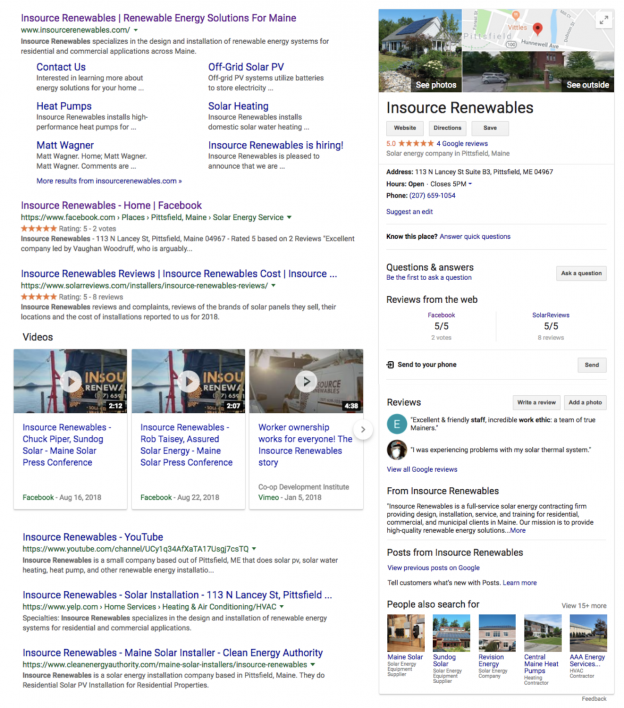
A search for “insource renewables pittsfield me” pulls up Insource Renewables’ Google home page.
This one page alone contains loads of information about your company, including your website, contact info, service area, reviews, and questions people are asking about your company. Our webinar about optimizing your Google home page can walk you through strengthening this page. You may also use Local U’s “Scoring Your Brand Page” feature to assess the current state of your Google home page.
More and more people are interacting with businesses via the Google home page, without ever visiting the business’ website. So, refining your Google home page is more important now than ever before.
Website Domain Authority
Domain Authority is a metric developed by Moz which correlates with how Google might score your website. The higher your Domain Authority, the more trustworthy Google is likely to view your website.
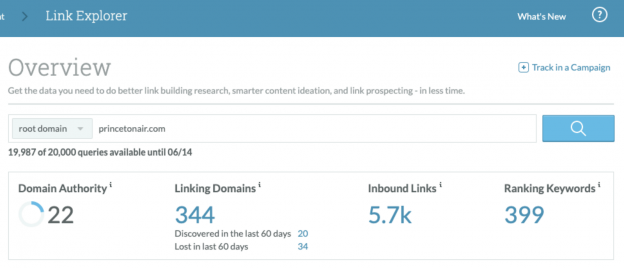
Your Domain Authority can help tell you how Google scores your website.
Domain Authority is scored out of 100, but for most small and local businesses, a good DA falls between 20 and 45.
You’ll need to run your website through Moz’s Domain Authority tool to determine your website’s DA. However, if you are not a Moz subscriber (and most contractors aren’t), we would be happy to run a check of your Domain Authority and send you a copy of the report.
Incoming Link Quantity & Quality
On a related note, the number-one factor which determines your Domain Authority is incoming link quantity and quality — so not just the number of links pointing to your website but also the quality of those links. For example, if a high-authority website like Energy.gov links to your website (say, in a press release about a particular DOE award you won), you can expect your Domain Authority to go up. The more incoming links, the better.
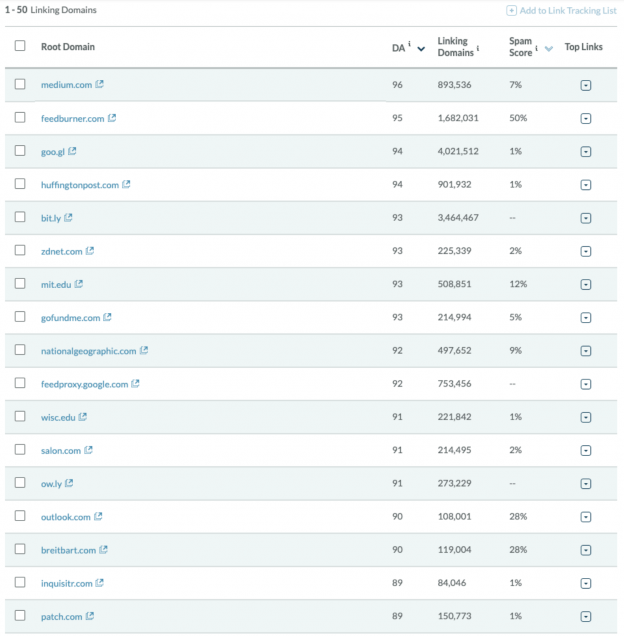
Incoming links have a major impact on your website’s Domain Authority and overall online brand.
If you want to increase your Domain Authority, you should seek more links from high-authority websites like Energy.gov, ENERGY STAR, local utility company websites, local news outlets, etc.
Direct Traffic to Website
“Direct traffic” refers specifically to website traffic that comes from people typing your URL into the browser’s address bar. Direct traffic metrics reflect how well customers know your URL, and how memorable your URL is. When looking at your website’s direct traffic metrics, be sure to consider two things: 1) the percentage of site traffic that is direct traffic, and 2) how your direct traffic has grown over time.
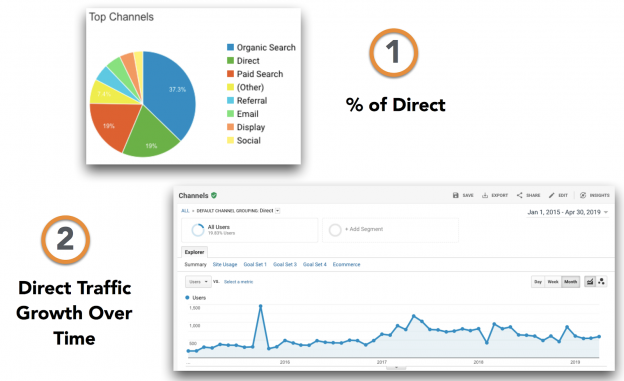
These direct traffic metrics can help you determine how well customers know your URL.
Of course, the higher these metrics are, the better. If your direct traffic numbers are not as high as you would like, then you know it’s time to put more messaging out there that tells customers who you are and how they can find you online.
Organic Brand Search Volume
“Organic brand search volume” refers to how many users are searching for your company on Google. Like direct traffic, this is a clear indicator of how well your target audience knows your brand.
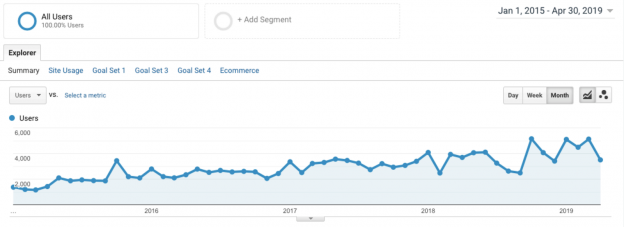
If you see a nice upward trending line of user traffic to your site from organic search, that’s a sign that brand awareness is growing.
If you see a nice upward trending line of user traffic to your site from organic search, that’s a sign that brand awareness is growing.
Google Review Quantity & Review Diversity
Reviews can shed a great deal of light on the strength of your brand as well. The more Google reviews your company has, the more strongly your company is resonating with your target audience. A good number of reviews to shoot for if you are a plumbing or HVAC contractor is about 40. (We discuss review quantity at length in our blog post titled “A Deep Dive into Reviews.”)
Keep in mind that it isn’t just Google reviews that matter. It’s also important to garner reviews from third-party sites like Facebook, Better Business Bureau, Yellow Pages, Citysearch, Insider Pages, Yellow Bot, and Super Pages. That said, be sure to focus mainly on diversity with these other third-party sites; Google review quantity is still the most important thing here.
If your company does not have as many reviews as you would like, now is a good time to ask some of your loyal customers to review you if they haven’t already.
Directory Listing Volume & Consistency
How many directories is your business listed in across the web? (Think Google, Bing, Yahoo, Yellow Pages, Facebook, Instagram, Hotfrog, Super Pages, etc.) The more complete and consistent your company information is across various business directories, the easier it is for Google to triangulate you as a company.
Moz offers a tool called Moz Local which allows you to see how complete and consistent your company info is.
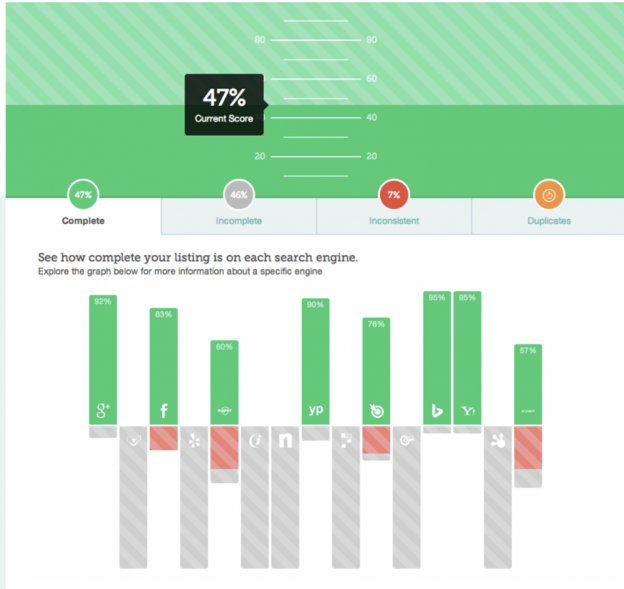
The Moz Local tool shows you where you are listed in online directories, where information is inconsistent or incomplete, and which listings you should update.
Bottom line: having a clean and robust citations landscape is good for your brand.
Engagement
“Engagement” refers to how users interact with your company online. It encompasses a number of key metrics, including:
-
On Your Website
-
Time on site
-
Pages per session
-
Bounce rate
-
Third Party Review Landscape
-
Number of Google reviews
-
Diversity of reviews
-
Within Google My Business
-
Clicks on Google Posts
-
Click to call
-
Q&A volume & response
-
Send to phone
Google has added a number of engaging features to Google My Business in the past year or two (like Questions & Answers and Google Posts), so engagement seems to be a key metric that continues to grow in importance.
There’s no “quick fix” to increasing brand engagement, but we recommend tactics like adding engaging content to your website, making your website easy to navigate, responding to reviews, responding to questions asked on your GMB profile, responding to comments on your Facebook page or posts, using the GMB Google Posts feature, send regular email newsletters, etc. In general, give your audience as many options for how to find you, understand you and contact you, as possible.
How Strong Is Your Brand?
Defining the strength of your brand can feel a lot like “measuring the unmeasurable,” but with the right metrics, you can gain invaluable insight into how your brand is resonating with your target audience online. And when you take active steps to strengthen your brand online, you’ll see higher conversion rates and, ultimately, more revenue.